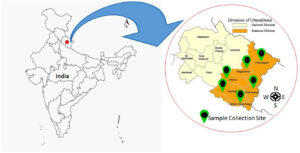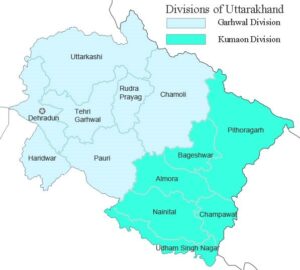Commissioner of Kumaon Divisions

The Commissioner of Kumaon Divisions , located in the northern Indian state of Uttarakhand, is a region of captivating beauty, cultural diversity, and historical significance. Nestled in the Himalayas, Commissioner of Kumaon Divisions is renowned for its picturesque landscapes, which include lush green valleys, rolling hills, and snow-capped peaks. Divided into six districts – Almora, Bageshwar, Champawat, Nainital, Pithoragarh, and Udham Singh Nagar – the division spans a wide range of altitudes, offering a diverse array of flora and fauna.

The region boasts several renowned hill stations, with Nainital being the most famous. Surrounded by the Naini Lake, this hill town attracts visitors with its pleasant climate and colonial architecture. The historic town of Almora, with its narrow cobbled streets and ancient temples, adds to the cultural richness of Kumaon. Pithoragarh, known as the “Little Kashmir,” is famed for its breathtaking views of the Himalayan peaks and is a gateway to the Kailash Mansarovar pilgrimage route.
Kumaon’s cultural heritage is deeply rooted in its traditional folk music, dance forms, and festivals. The region celebrates various fairs and events, such as the Nanda Devi Raj Jat Yatra, showcasing the cultural vibrancy and religious fervor of the locals.
Apart from its scenic beauty and cultural charm, Commissioner of Kumaon Divisions has historical significance. The region has been mentioned in ancient Hindu texts and witnessed the influences of various dynasties, including the Katyuri and Chand rulers. The forts, temples, and archaeological sites scattered across Kumaon narrate tales of its rich past.
Kumaon is not only a tourist destination but also an adventurer’s paradise. The region offers opportunities for trekking, wildlife safaris, and nature walks. Jim Corbett National Park, located in the Nainital district, is one of the oldest national parks in India and a haven for wildlife enthusiasts.
In essence, the Commissioner of Kumaon Divisions division is a mosaic of natural beauty, cultural heritage, and historical significance. Its diverse landscapes and offerings make it a compelling destination for those seeking a blend of tranquility, adventure, and a deep dive into the cultural tapestry of the Himalayan region.

Kumaon, with its serene hill stations and vibrant towns, has been a center for spiritual and religious activities. The region is dotted with ancient temples and sacred sites that hold immense significance for devotees. The Jageshwar group of temples in Almora, dedicated to Lord Shiva, is an archaeological and spiritual gem with over a hundred temples set amidst a dense deodar forest. The Baijnath Temple in Bageshwar, built in the 12th century, is another notable shrine reflecting the architectural and religious heritage of Kumaon.
The Kumaoni cuisine is a delightful aspect of the region, featuring a variety of local dishes that showcase the flavors and traditions of the area. Bhatt ki Churkani, Aloo Ke Gutke, and Singodi (a sweet delicacy) are among the culinary delights that visitors often savor. The local markets in towns like Almora and Nainital are vibrant with traditional crafts, handwoven textiles, and unique handicrafts, providing an opportunity for visitors to take home a piece of Kumaon’s cultural richness.
Kumaon has inspired numerous writers and poets, with its enchanting landscapes serving as the backdrop for literary works. The legendary Jim Corbett, known for his wildlife conservation efforts, found his inspiration in the jungles of Kumaon. The region’s timeless charm has also been celebrated in the writings of luminaries like Mahadevi Varma and Sumitranandan Pant.
The Commissioner of Kumaon Divisions has actively embraced sustainable tourism practices, emphasizing responsible travel and conservation. Initiatives to protect the environment and preserve the cultural heritage contribute to the region’s enduring allure.

In conclusion, the Kumaon division remains an alluring destination that seamlessly blends spirituality, history, culture, and natural beauty. Whether it’s the snow-clad peaks, ancient temples, vibrant festivals, or the warm hospitality of its people, Kumaon continues to captivate the hearts of those who venture into its diverse and enchanting landscapes.
Commissioner of Kumaon Divisions , with its rich tapestry of experiences, is also a gateway to numerous off-the-beaten-path destinations and hidden gems. Mukteshwar, a serene town in Nainital district, offers panoramic views of the Himalayas and is known for its old-world charm and fruit orchards. Ranikhet, often referred to as the “Queen’s Meadow,” is another delightful hill station that captivates visitors with its meadows, pine-covered hills, and ancient temples.
For adventure enthusiasts, Kumaon presents opportunities for trekking and exploration. The Pindari Glacier trek in the Bageshwar district is a thrilling journey through pristine landscapes, allowing trekkers to witness the awe-inspiring beauty of the Himalayan glaciers. The Milam Glacier trek in the Pithoragarh district is another challenging yet rewarding expedition that takes trekkers deep into the heart of the Himalayas.
Kumaon’s lakes add to the region’s scenic allure. Bhimtal, Naukuchiatal, and Sattal are picturesque lakes surrounded by dense forests and hills, offering tranquility and opportunities for boating and bird watching.
The region’s festivals, such as the Uttarayani Mela celebrated in Bageshwar, provide a glimpse into the traditional customs and cultural vibrancy of Commissioner of Kumaon Divisions . The celebration of Phool Dei, where flowers and sweets are exchanged to mark the onset of spring, is a unique and joyous tradition observed in various parts of the region.
Kumaon’s connection to folklore and legends is evident in places like Kausani, often referred to as the “Switzerland of India.” This scenic hill station is believed to be the place where the famous poet Sumitranandan Pant composed his poetry, drawing inspiration from the breathtaking Himalayan panorama.
In recent years, Kumaon has also emerged as a hub for wellness and spiritual retreats. Several yoga and meditation centers nestled in the serene landscapes provide seekers with an opportunity to rejuvenate mind, body, and soul.
As one explores the lesser-known facets of Commissioner of Kumaon Divisions , it becomes evident that this region is not just a destination; it’s a diverse and enchanting tapestry of experiences waiting to be unraveled by those who venture beyond the well-trodden paths.
Unveiling the Role of the Commissioner of Kumaon Division in Uttarakhand
Introduction
Nestled in the lap of the majestic Himalayas, Uttarakhand is a state of diverse landscapes and rich cultural heritage. The administrative framework of Uttarakhand consists of two divisions, each playing a crucial role in the governance and development of the state. In this blog, we shine a spotlight on the Commissioner of Kumaon Division, delving into the responsibilities and impact of this esteemed position.
The Office of the Commissioner
The Commissioner of Kumaon Division operates from the administrative heartland of the region, overseeing the diverse districts that constitute Commissioner of Kumaon Divisions . This administrative hub serves as a linchpin, orchestrating various governmental functions to ensure the smooth functioning of the division.
Key Responsibilities of the Commissioner
The Commissioner of Kumaon Division shoulders a range of responsibilities, contributing significantly to the overall development and governance of the region. Let’s explore some of the pivotal tasks associated with this role:
- Administrative Oversight: Acting as the chief administrative officer, the Commissioner ensures the efficient functioning of government offices and departments within the Kumaon Division.
-

Commissioner of Kumaon Divisions Law and Order Maintenance: The Commissioner collaborates with local law enforcement agencies to maintain law and order in the division, fostering a secure environment for the residents of Kumaon.
- Development Planning: Playing a vital role in the development trajectory of Kumaon, the Commissioner participates in the planning and execution of various developmental projects, ranging from infrastructure to social welfare.
- Coordination with District Administrations: Kumaon Division comprises several districts, and the Commissioner serves as a crucial link between the state government and the district administrations. This coordination ensures effective implementation of policies and programs.
- Crisis Management: During emergencies or natural disasters, the Commissioner is at the forefront of crisis management, orchestrating timely responses, mobilizing resources, and providing support to affected communities.
Impact on Kumaon’s Progress: The role of the Commissioner extends far beyond administrative duties, leaving a lasting impact on the development and progress of Kumaon. Here’s how:
- Infrastructure Advancement: The Commissioner spearheads infrastructure projects that enhance connectivity, healthcare, education, and other essential services, fostering overall development in the region.
- Tourism Promotion: Kumaon is renowned for its scenic beauty. The Commissioner actively promotes tourism by showcasing the cultural and natural treasures of the region, contributing to the economic growth of local communities.
- Empowering Local Communities: Through various initiatives, the Commissioner works towards empowering local communities, ensuring inclusive development that respects and preserves the unique traditions of Kumaon.
- Environmental Conservation: Uttarakhand’s pristine environment is a jewel that requires protection. The Commissioner collaborates with environmental agencies to implement policies that safeguard the region’s ecological balance.
Conclusion: In conclusion, the Commissioner of Kumaon Division stands as a pivotal figure in Uttarakhand’s administrative landscape, steering the path of progress and development in one of the state’s most culturally rich and naturally endowed regions. Through effective governance, strategic planning, and a commitment to the welfare of the people, the Commissioner leaves an indelible mark on the tapestry of Kumaon’s growth and prosperity.
